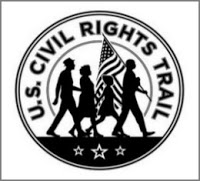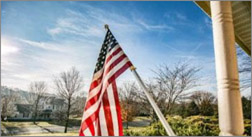In a rare decision under Section 2(b) of the Lanham Act, the
Board affirmed a refusal to register the mark shown below, for
tourism promotional services, on the ground that the mark includes
a simulation of the flag of the United States. The Board found that
U.S. flag and applicant's flag design "are highly similar
and that the average member of the public would perceive
Applicant's flag design to be a simulation of an actual U.S.
flag." Applicant pointed in vain to various flag-containing
registered marks, but the Board found them distinguishable and, in
any case pointed out once again that each application to register
must be considered on its own merits. In re Alabama Tourism Department, 2020
USPQ2d 10485 (TTAB 2020) [precedential] (Opinion by Judge
Christopher Larkin).

Section 2(b) prohibits registration of a mark that
"[c]onsists of or comprises the flag or coat of arms or other
insignia of the United States, or of any State or municipality, or
of any foreign nation, or any simulation thereof." The Board
has explained that this absolute bar to registration "reflects
the sentiment that such insignia are symbols of government
authority that ought to be reserved for signifying the government.
In re Dist. of Columbia, 101 USPQ2d 1588, 1597 n.14 (TTAB
2012), aff'd sub nom In re City of Houston, 731 F.3d
1326, 108 USPQ2d 1226 (Fed. Cir. 2013).
The word "comprises" in Section 2(b) means
"includes." Family Emergency Room, 121 USPQ2d at
1887 n.2. "[T]he word 'simulation' in the statute
'is used in its usual and generally understood meaning, namely,
to refer to something that gives the appearance or effect or has
the characteristics of an original item.'" Id.
(quoting Advance Indus., 194 USPQ at 346). The question is
"whether consumers will perceive matter in the mark as a
flag." Id. at 1888.
These factors should be applied to both color and
black-and-white drawings. TMEP Section 1204.01(a)
TMEP Section 1204.01(b) lists five scenarios under where
registration should not be refused under § 2(b) and includes
seven examples of registrable stylized designs of the American
flag:
" The flag is substantially obscured by words or designs.
" The design is not in a shape normally seen in flags.
" The flag design appears in a color different from that normally used in the national flag.
" A significant feature is missing or changed.
Although the TMEP does not have the force of law [Hooray!
I've been saying this for years - ed.], the Board held
that "both sets of the 'above standards, as set forth in
the TMEP, are appropriate under the statute' to consider in
determining whether consumers will perceive a mark as consisting of
or comprising a flag. Family Emergency Room, 121 USPQ2d at
1888."
Applicant argued that the flag design in the subject mark (1) is
missing significant features of the American flag, (2) forms
another design, (3) is substantially obscured by other portions of
the mark, and (4) is not in a shape normally seen." It
maintained that the USPTO's registration of many marks that
contain obvious flag elements justifies registration of its
mark.
Examining Attorney William H. Dawe III argued that none of the five
scenarios of TMEP Section 1204.01(b) applies here, that the flag
depicted in the mark will be perceived as a simulation of a U.S.
flag, and that each application must be examined on its own
merits.

The determination of whether the mark is a prohibited simulation
of the U.S. flag requires a "visual comparisonn of the
[design] and the actual flag." Family Emergency Room,
121 USPQ2d at 1887 (citing Waltham Watch, 179 USPQ at
60).
The Board found that the mark contains "unmistakable feature
of the flag." In fact, in applicant's original description
of the mark. it identified the flag as the "the U.S.
flag." The reference to "U.S." in the leaves
no doubt that, as applicant originally stated, "the man in
front [is] holding a stick bearing the U.S. flag over his
shoulder."
The Board found that U.S. flag and applicant's flag design
"are highly similar and that the average member of the public
would perceive Applicant's flag design to be a simulation of an
actual U.S. flag."
Applicant's arguments that a number of features of the flag are
missing missed the mark. The fact that the flag is displayed in
this manner is not uncommon, and "no reasonable observer of
that flag would believe that features are missing or changed, or
view it as something other than the U.S. flag."

Applicant's mark is not incorporated into wording or into
another design, as is the case in registered marks cited by the
applicant. And in some registered marks, the flag design is
depicted with significant features changed or missing.
Nor is the flag "substantially obscured" by other
elements in the mark, nor is the flag "not in the normal flag
shape." It is not elongated or strangely shaped, as some
of the examples in the TMEP. "It would be perceived as the
U.S. flag or a simulation thereof."
Applicant strongly argued that, when other registered flag marks
are considered, the refusal in this case is "clearly
inconsistent with what this applicant had come to expect from the
United States Patent and Trademark Office over the past decade of
prosecuting several similar applications." Applicant accused
the examining attorney of a "refusal to address this need for
consistent treatment at the Trademark Office is surely not an
oversight as indeed, it would be impossible for the Examining
Attorney to reconcile his decision to deny registration here with
the decision to register or allow these other marks." The
Board was unimpressed.
He properly determined that the mark was unregistrable under the
statute, and neither he nor we have any obligation "to
reconcile his decision to deny registration here with the decision
to register or allow . . . other marks." *** In addition,
Applicant's evidentiary submission almost certainly presents an
incomplete picture of USPTO practice, as it omits marks in
applications that were refused registration under § 2(b) in a
manner likely to be highly consistent with the action in this
case."
As stated by the CAFC in Nett Designs, 57 USPQ2d at 1566),
"the Board (and this court in its limited review) must assess
each mark on the record of public perception submitted with the
application."
And so the Board affirmed the Section 2(b) refusal.
Article originally published on 7 May 2020
The content of this article is intended to provide a general guide to the subject matter. Specialist advice should be sought about your specific circumstances.

